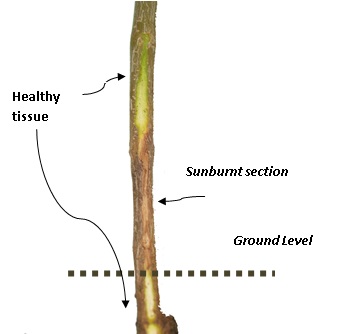Many fruit trees are susceptible to sunburn damage as young, newly planted trees in the field. Sunburn on young trees can seriously affect growth and in some cases, be fatal.
In most cases sunburn is expressed as a slow tree decline. The canopy takes on an unthrifty appearance as the leaves yellow and slowly dry out.
The trunks of affected trees do not develop normally and they tend to look thin and spindly. A brown slightly sunken canker (usually 5-8cm in length) develops on the trunk just above ground level.
Although the symptoms of sunburn can resemble other problems such as Phytophthora root rot, verticillium wilt or hare damage they can be easily diagnosed with a little investigation.
On young fruit trees, sunburn damage almost always occurs low on the trunk just above ground level. This is where the suns radiation and reflection off the ground concentrates to cause the most damage. Where the sun damages the tree the tissue becomes brown and slightly sunken.
To identify a sunburn problem, look for damaged tissue at the base of the trunk. Using a sharp knife remove a very thin sliver of the bark tissue from the trunk, starting at ground level to about 10cm high.
If the internal tissue underneath is brown this is an indication that the trunk has been sunburnt. The internal tissue will always be green below and above the sunburnt section. If the internal tissue is brown from below the ground or is browning from the tips of the branches back down the trunk sunburn is usually not the cause of the problem.
Sunburn can be fatal on young trees because it destroys the water conducting tissue that enables water and nutrients to move from the roots to the tree canopy. In some cases the trees can survive by producing new shoots from below the damaged area. These shoots can be used to regenerate the tree if they are above the graft union.
Allow the shoots to grow for a few months then select the most vigorous shoot to become the main trunk. Tie it to the stake and remove the others.
Newly planted trees can be easily protected from sunburn by either painting the trunks with a white water-based paint diluted 50:50 with water or by using trunk wraps or tree guards. Generally one application at the time of planting is enough to protect the tree through the establishment phase.
Older trees can also be affected by sunburn but this usually only occurs when trees are pruned back very hard in the summer exposing the trunk and shaded inner limbs to the harsh summer sun. Sunburn or sunscald on older trees is evidenced by dark patches of discoloured stem which lead to cracking and peeling of the bark.
Sunburn is best prevented by waiting until winter to hard prune trees and/or by painting the exposed trunk and limbs with a lime based whitewash as soon as they are pruned.
Lime white wash can be made with 1000ml water, 350g, hydrated lime and 100g table salt. Add the salt and water together and slowly stir in the lime until a consistency similar to paint is achieved. Add more water if necessary.
Paint the limbs till a good white layer of protection is evident. A couple of coats may be necessary. The white wash is not permanent. It will protect the trees for the summer months and then slowly fade over time.
Take caution when using hydrated lime as it is quite caustic. When handling the lime, avoid contact with skin and eyes and avoid breathing the dust (wear suitable gloves and eye/face protection).

